|
Battle of Chickamauga Maps
| Chickamauga Campaign Map |
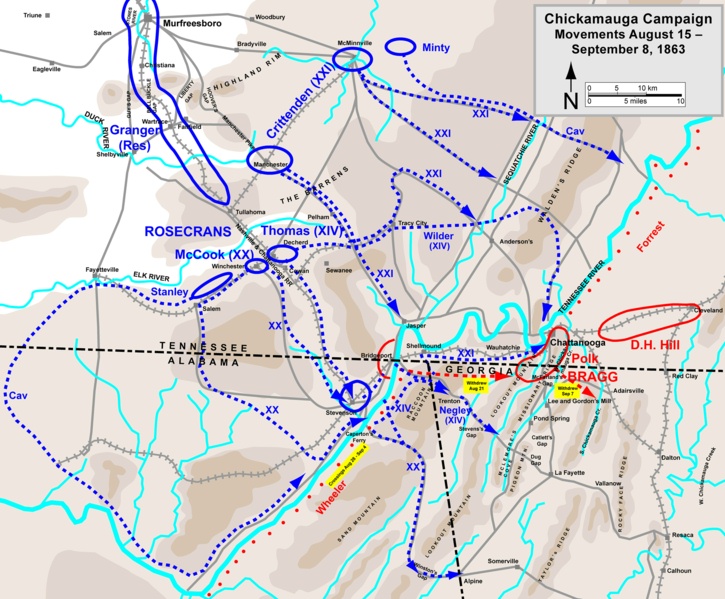
|
| (The Battle of Chickamauga Map) |
Initial Union and Confederate army movements in the Chickamauga Campaign, August 15 – September 8, 1863.
| Davis's Cross Roads, September 11, 1863 |
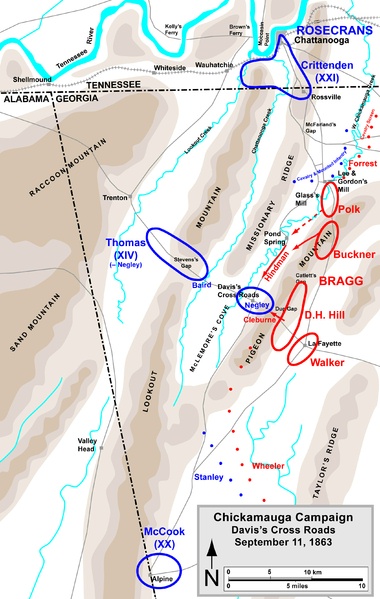
|
| (Chickamauga Battlefield Map) |
Battle of Chickamauga: Davis's Cross Roads, September 11, 1863.
| September 18 movements on the eve of the Battle |
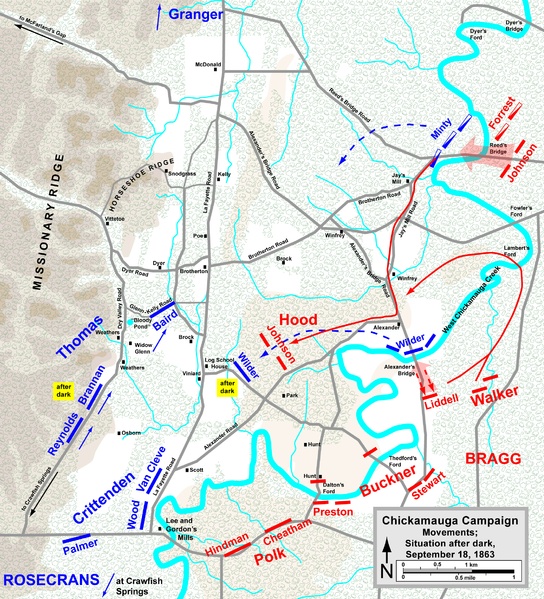
|
| (Battle of Chickamauga Map) |
Union and Confederate battlefield movements at Chickamauga on the eve
of September 18, 1863.
| Actions, morning of September 19 |
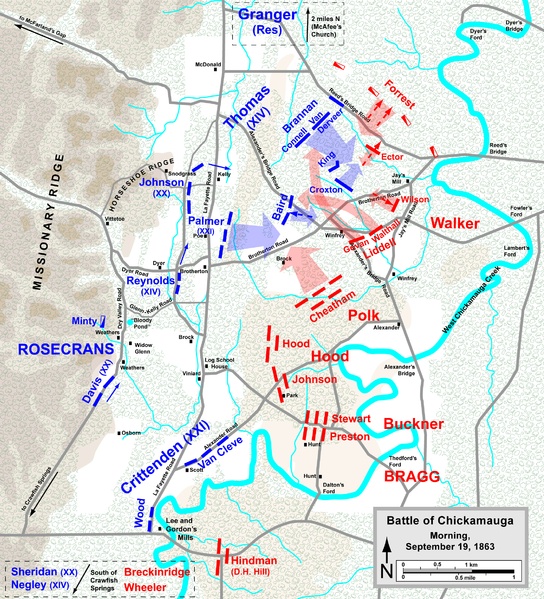
|
| (Battle of Chickamauga Map) |
Union and Confederate troop actions on the morning of September 19, 1863.
| Actions, early afternoon of September 19 |
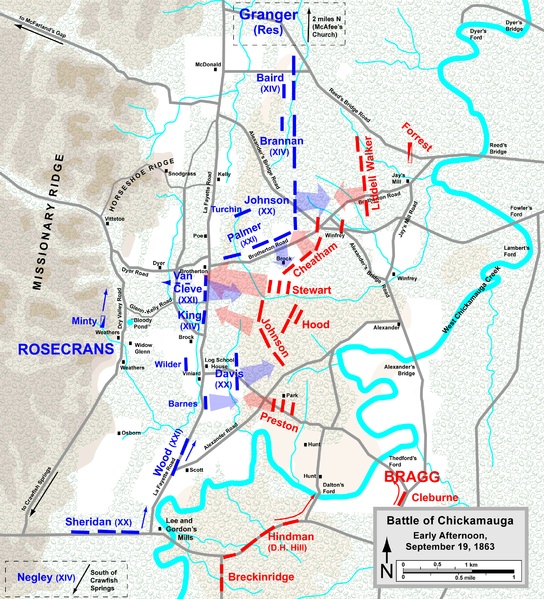
|
| (Battle of Chickamauga Map) |
Union and Confederate armies in action on the early afternoon of September 19, 1863.
| Actions, late afternoon to dark, September 19 |
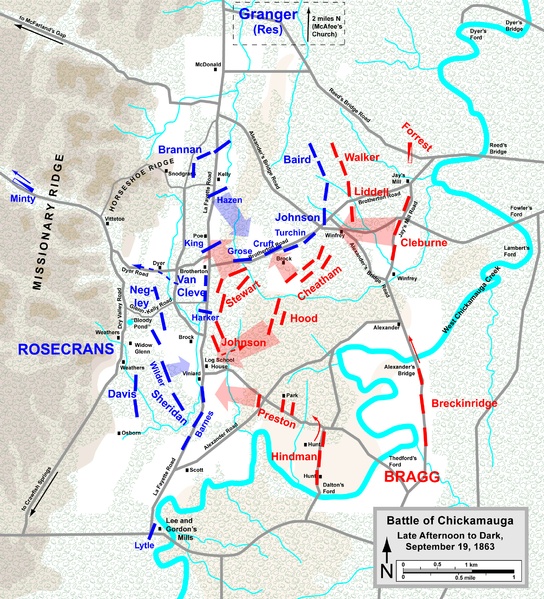
|
| (Battle of Chickamauga Map) |
Union and Confederate army movements, late afternoon to dark, September
19, 1863.
| Polk's Right Wing assaults, morning, September 20 |
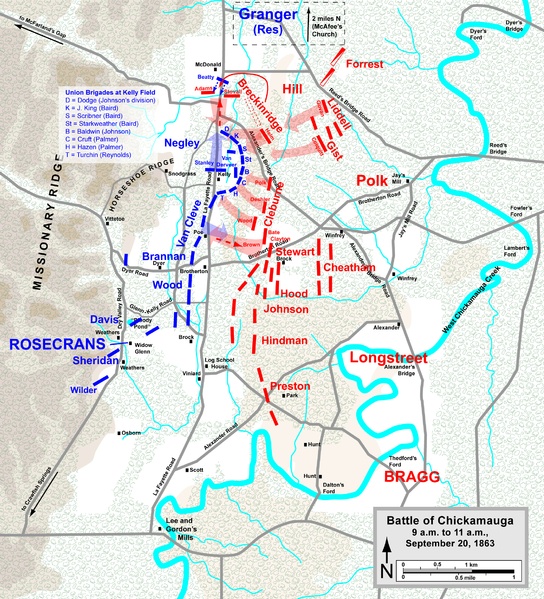
|
| (Battle of Chickamauga Map) |
General Polk's Right Wing assaults on the morning of September 20, 1863.
| Longstreet's Left Wing assaults, mid-day Sept. 20 |
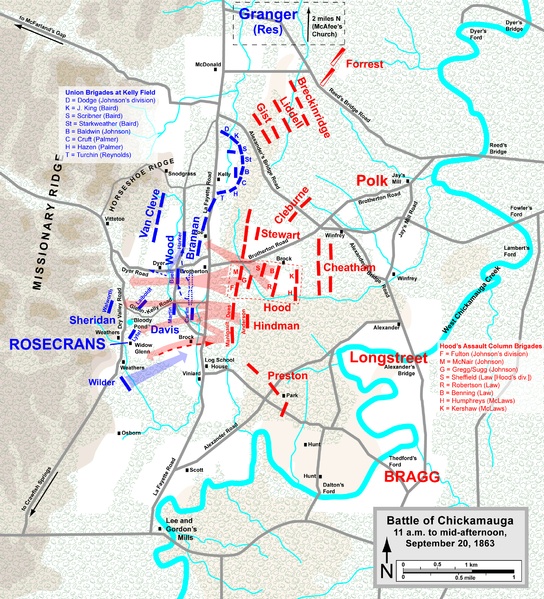
|
| (Battle of Chickamauga Map) |
General Longstreet's Left Wing assaults, mid-day, September 20, 1863.
| Horseshoe Ridge Defense & Union retreat, Sep. 20 |
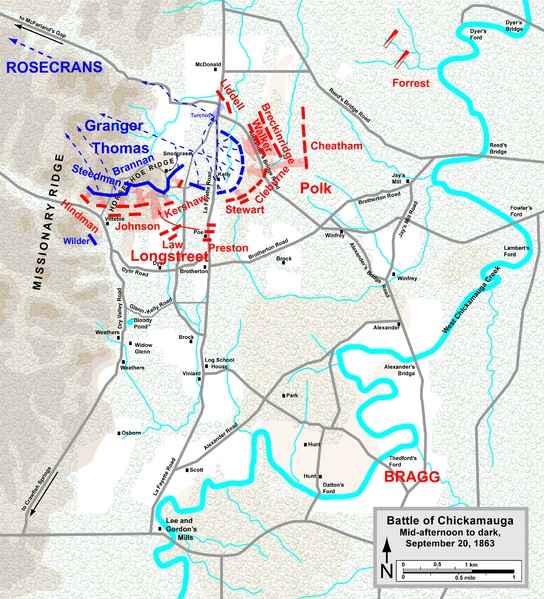
|
| (Battle of Chickamauga Map) |
Defense of Horseshoe Ridge and Union Army retreat, afternoon and evening
of September 20, 1863.
| Horseshoe Ridge Defense & Union retreat |
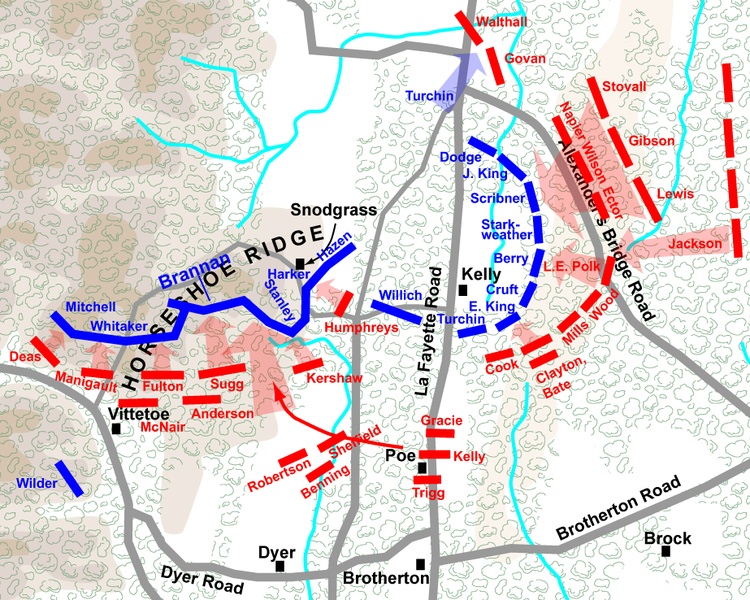
|
| (Battle of Chickamauga Map) |
Defense of Horseshoe Ridge, Union retreat, and brigade details, on September 20, 1863.
Recommended
Reading: Chickamauga:
A Battlefield Guide (This Hallowed Ground: Guides to Civil War). Description: Providing an overview of
this dramatic battle of the Civil War, this book also provides an on-site tour to help both serious students and casual visitors
get the most out of a visit to the location. "These 43 detailed maps are a must have for the buff... Chickamauga was the second
bloodiest battle of the Civil War, and these maps are a wonderful guide to its battlefield." From Lookout Mountain to Missionary
Ridge to Chickamauga Battlefield, each map is precise. Continued below…
About the Author: Steven E. Woodworth
is an assistant professor of history at Texas Christian University. His books include Six Armies in Tennessee:
The Chickamauga and Chattanooga Campaigns (Nebraska 1998).
Recommended Reading: Guide to the Battle of Chickamauga
(The U.S. Army
War College Guides to Civil
War Battles). Description: "The most thorough, detailed, and accurate books of their kind. I have used them [U.S. Army War
College Guides to Civil War Battles] to lead guided tours of several battlefields, with great success", -- James M. McPherson,
Pulitzer Prize winning author.
Recommended
Reading: Historic Photos of Chickamauga and
Chattanooga (Historic Photos) (Hardcover). Description: The campaign from Murfreesboro,
Tennessee, to Chickamauga, Georgia,
followed by the siege of Chattanooga, is one of the most dramatic
stories of the entire Civil War. Union Major General William S. Rosecrans led a brilliant advance into Georgia, taking Chattanooga
with the loss of only six men. Near Chickamauga Creek, Confederate General Braxton Bragg routed Rosecrans army, then laid
siege to it from the heights around Chattanooga. Continued
below…
Major General
Ulysses S. Grant, recently given command of virtually all Federal armies in the Western Theater, arrived to break the siege.
A climatic Union charge routed Bragg s demoralized army. Historic Photos of Chickamauga Chattanooga tells this story and much
more, for it includes the important struggle to preserve America’s Civil War battlefields, which began with Chickamauga. Striking black-and-white images of aging veterans, reuniting to preserve their
history, join photos of the rugged terrain over which they fought in 1863. This is a compelling American story told in photographs,
with text by a noted historian.
Recommended Reading: This Terrible Sound: THE BATTLE OF CHICKAMAUGA (Civil War Trilogy)
(Hardcover: 688 pages) (University of Illinois Press). Description:
Peter Cozzens is one of those amazing writers that brings you onto the
field and allows you to experience the campaign. You advance with Cleburne's
Division as it moves through the dusk shrouded woods and your pulse races as you envision Gen. Lytle's command trying to decide
whether to save their dying commander or flee as the Rebs pound up that smoke-filled hill. Continued below...
This
account of the Battle of Chickamauga is first rate and thrilling. The profusion of regimental and brigade disposition maps
are particularly useful for any serious visit to the battlefield. There are some intriguing ideas introduced as well. Forrest's
role in the early stages of the battle is fascinating to read and to contemplate. Also revealing are the ammunition problems
that plagued the mounted units; a problem that would hinder Forrest's command at Spring Hill a year later.
Recommended Reading: Six Armies in Tennessee: The Chickamauga
and Chattanooga Campaigns (Great Campaigns of the Civil War). Description: When
Vicksburg fell to Union forces under General Grant in July 1863, the balance turned against the Confederacy in the trans-Appalachian
theater. The Federal success along the river opened the way for advances into central and eastern Tennessee, which culminated
in the bloody battle of Chickamauga and then a struggle for Chattanooga. Continued below...
Chickamauga is usually counted as a Confederate victory, albeit a costly
one. That battle—indeed the entire campaign—is marked by muddle and blunders occasionally relieved by strokes
of brilliant generalship and high courage. The campaign ended significant Confederate presence in Tennessee and left the Union
poised to advance upon Atlanta and the Confederacy on the brink of defeat in the western theater.
Recommended Reading: Chickamauga 1863: The River
Of Death (Campaign). Description: By the autumn
of 1863 the Confederacy was in dire straits. In a colossal gamble, Confederate President Jefferson Davis stripped forces from
all the major Confederate armies to reinforce the Army of Tennessee in a last ditch attempt to crush the Union.
On 19th September the Confederates attacked the Union army along Chickamauga creek south of
Chattanooga. On the second day of bloody fighting the entire
Union right collapsed and the army retreated headlong for Chattanooga, all except General George
H. Thomas' Corps who fought on doggedly until nightfall delaying the confederate advance, saving the Union
and earning his fame as the "Rock of Chickamauga". Continued below…
About the Author: James R. Arnold
is a US-born freelance writer who has contributed to numerous military publications. James spent his formative years in Europe and used the opportunity
to study the sites of historic battlefields. He has more than 15 published books to his credit, many of them focusing on the
Napoleonic campaigns and American Civil War.
|

